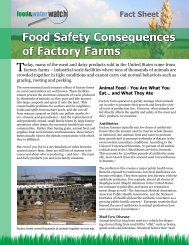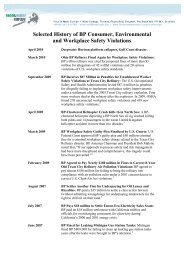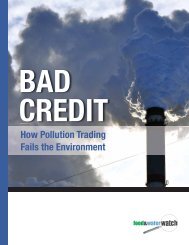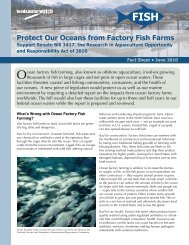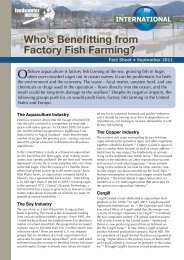How New York State Exaggerated Potential Job Creation from Shale ...
How New York State Exaggerated Potential Job Creation from Shale ...
How New York State Exaggerated Potential Job Creation from Shale ...
You also want an ePaper? Increase the reach of your titles
YUMPU automatically turns print PDFs into web optimized ePapers that Google loves.
Introduction<br />
The oil and gas industry, 5 industry-funded academics 6<br />
and ideological think tanks 7 have promoted shale gas<br />
development as a sure-fire job creator in difficult<br />
economic times. Proponents of shale gas development<br />
have benefited <strong>from</strong> media 8 and U.S. government 9<br />
reports in which the supposed economic benefits have<br />
gone unquestioned. Food & Water Watch recently<br />
analyzed one industry-backed job projection and found<br />
that it overstated shale gas job creation potential in<br />
<strong>New</strong> <strong>York</strong> by a factor of 10, or about 900 percent. 10<br />
<strong>New</strong> <strong>York</strong>’s job projection follows a similar methodology<br />
and suffers <strong>from</strong> similar flaws. A topline claim in<br />
the <strong>New</strong> <strong>York</strong> socioeconomic impact analysis is that<br />
53,969 jobs could be created assuming an “average”<br />
scenario of shale gas development. 11 But this is a<br />
30-year projection. 12 It assumes that a total of 42,126<br />
shale gas wells would be developed over 30 years,<br />
including 21,067 in just the three counties of Broome,<br />
Chemung and Tioga. 13<br />
Close examination of this job projection shows that<br />
allowing for such extensive shale gas development<br />
in <strong>New</strong> <strong>York</strong> would actually have a minimal impact<br />
on employment in the near term, primarily because<br />
most jobs would go to employees <strong>from</strong> out-of-state.<br />
<strong>Shale</strong> gas development would not provide the broadbased<br />
economic growth that <strong>New</strong> <strong>York</strong> now needs and<br />
that the industry has promised they could deliver.<br />
Instead, shale gas development would primarily benefit<br />
the oil and gas industry while bringing significant<br />
costs to public health, public infrastructure, and<br />
the environment.<br />
<strong>New</strong> <strong>York</strong>’s shale gas job projection<br />
The consulting company Ecology and Environment, Inc.<br />
(E&E Inc.) was hired to conduct <strong>New</strong> <strong>York</strong>’s analysis of<br />
the impact that shale gas development would have on<br />
employment in the state. 14 E&E Inc. produced a report<br />
describing their methodology and findings that became,<br />
after minor revisions, Section 6.8 of the <strong>New</strong> <strong>York</strong> <strong>State</strong><br />
Department of Conservation (NYSDEC) “Revised Draft<br />
Supplemental Generic Environmental Impact <strong>State</strong>ment”<br />
(SGEIS). 15 Under <strong>New</strong> <strong>York</strong>’s “average” development<br />
scenario, A the analysis concluded that 53,969<br />
jobs would be created <strong>from</strong> drilling and fracking 42,126<br />
shale gas wells over 30 years, compared to the baseline<br />
of no shale gas development. 16<br />
<strong>Job</strong>s before production versus jobs during production<br />
<strong>New</strong> <strong>York</strong>’s 30-year projection of 53,969 jobs comes<br />
<strong>from</strong> three separate projections: a projected 17,634<br />
“construction” jobs <strong>from</strong> the preparing, drilling and<br />
fracking of 1,652 shale gas wells in year 30; a projected<br />
7,161 “production” jobs that have accumulated over<br />
the 30 years as more and more wells are brought into<br />
production; and a projected 29,174 “indirect” jobs created<br />
by the economic spillover effects of construction<br />
and production jobs. 17<br />
A 2009 study by the Marcellus <strong>Shale</strong> Education &<br />
Training Center (MSETC) on future education and<br />
training needs in Pennsylvania is the basis, in the<br />
<strong>New</strong> <strong>York</strong> study, of this distinction between jobs before<br />
production and jobs during production. 18 <strong>How</strong>ever, to<br />
make this distinction, MSETC uses the terms “drilling<br />
phase jobs” and “production phase jobs,” even though<br />
some of the drilling phase jobs are associated with<br />
pre-drilling activities. 19 <strong>New</strong> <strong>York</strong>’s use of the term<br />
“construction jobs” obscures the fact that the drilling<br />
(and pre-drilling) phase of well development includes<br />
white-collar jobs, such as lawyers, lobbyists, accountants,<br />
engineers and office assistants, in addition to<br />
jobs directly associated with building access roads,<br />
constructing pipelines, clearing land and drilling and<br />
fracking. 20 A more accurate distinction is used in this<br />
report: pre-production phase jobs versus production<br />
phase jobs.<br />
It takes less than one year to prepare a well site and<br />
conduct the drilling and fracking. 21 As a consequence,<br />
the number of pre-production phase jobs increases<br />
<strong>from</strong> one year to the next only if the number of new<br />
wells developed each year increases; if the number of<br />
new wells drilled and fracked stays constant, then no<br />
new pre-production phase jobs would be created.<br />
A Three development scenarios were developed based on information<br />
<strong>from</strong> the Independent Oil & Gas Association of <strong>New</strong> <strong>York</strong> (IOGA-NY).<br />
The NYSDEC SGEIS only reports the “low” and “average” development<br />
scenarios.<br />
<strong>How</strong> <strong>New</strong> <strong>York</strong> <strong>State</strong> <strong>Exaggerated</strong> <strong>Potential</strong> <strong>Job</strong> <strong>Creation</strong> <strong>from</strong> <strong>Shale</strong> Gas Development • November 2011 3







